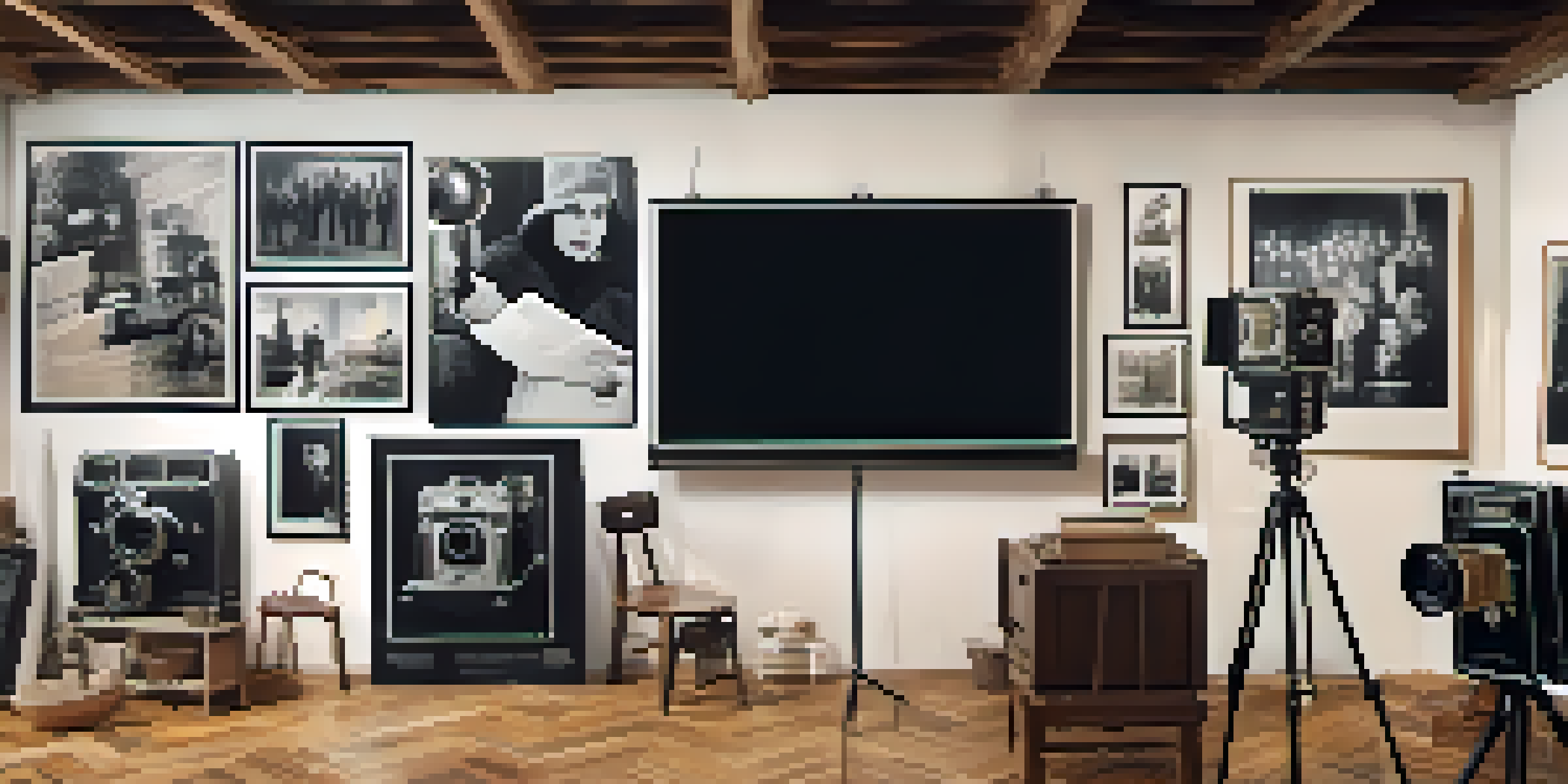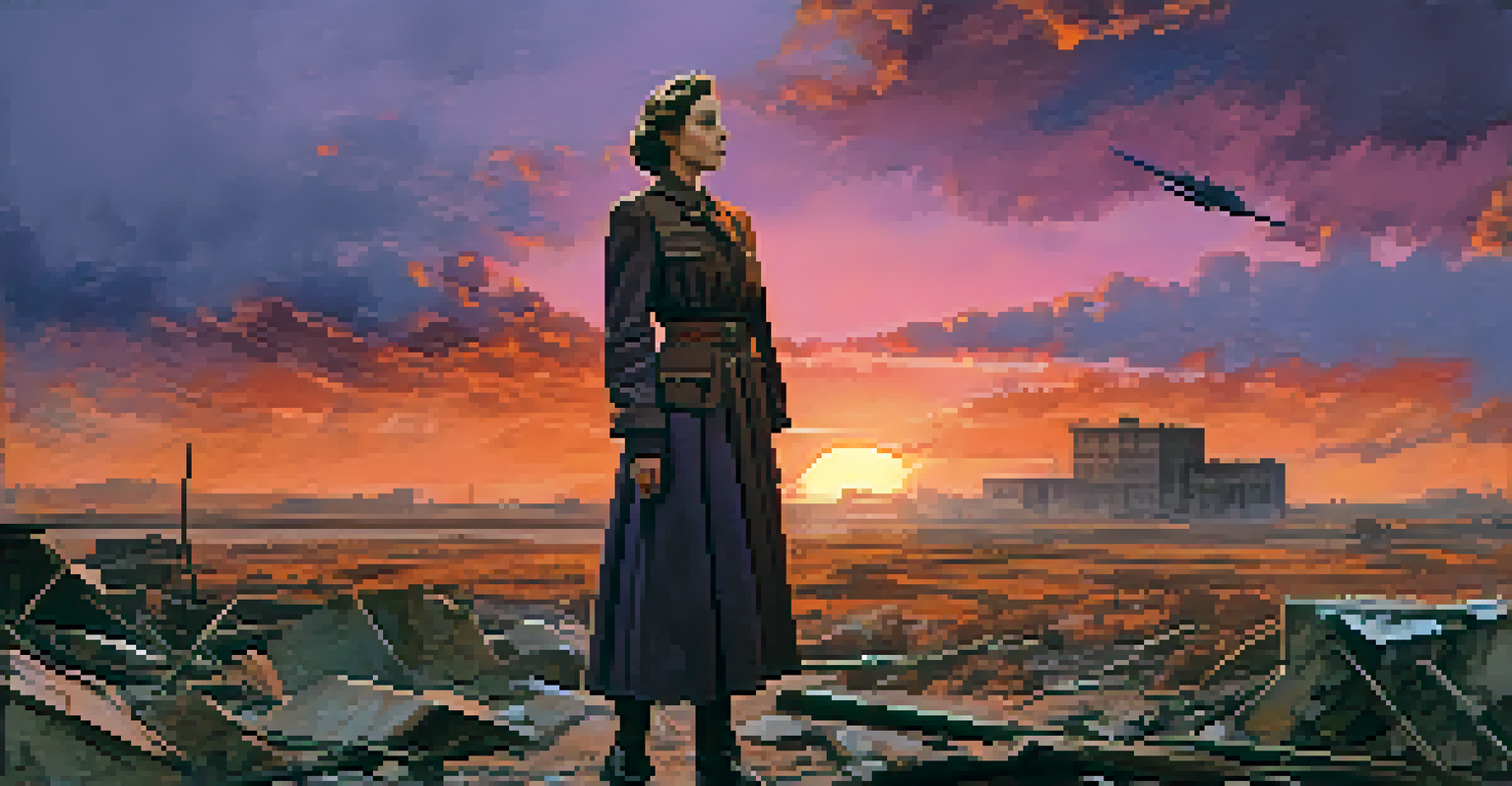The Legacy of Soviet Cinema: Key Films and Filmmakers

The Rise of Soviet Cinema: A Historical Overview
Soviet cinema emerged in the early 20th century, shaped by the political climate of the time. After the Bolshevik Revolution in 1917, filmmakers began to explore themes of ideology and revolution, using film as a tool for propaganda and cultural education. This period saw the birth of groundbreaking techniques that would influence cinema worldwide.
The cinema is a great instrument of education and propaganda, a powerful weapon in the hands of the revolutionaries.
Directors like Sergei Eisenstein pioneered innovative storytelling methods, such as montage, which juxtaposed images to create emotional resonance. His film 'Battleship Potemkin' remains a classic example of how cinema can convey powerful messages through visual editing. The impact of these early films laid the foundation for the rich tapestry of Soviet cinema.
As the years progressed, Soviet films became a blend of artistry and ideological expression, reflecting the complexities of life under a totalitarian regime. This unique intersection of politics and creativity would shape the landscape of global cinema for decades to come.
Key Themes in Soviet Cinema: Ideology and Propaganda
One of the most significant aspects of Soviet cinema is its focus on ideology and propaganda. Films often depicted the ideals of socialism, highlighting collective achievements and the importance of the state. This thematic emphasis was not just for entertainment; it aimed to educate and inspire the masses.

For instance, movies like 'The Fall of Berlin' and 'The Cranes Are Flying' showcased the heroism of Soviet citizens during WWII, reinforcing national pride and unity. While these films served the state agenda, they also provided a lens into the struggles and aspirations of the people, creating a complex narrative.
Soviet Cinema: Art Meets Ideology
Soviet cinema intertwines artistic expression with ideological themes, using film as a medium for propaganda and cultural education.
However, the use of propaganda did not stifle creativity. Many filmmakers found ways to infuse personal stories and artistic expression into their works, often critiquing the very system they were part of. This duality is what makes Soviet cinema both fascinating and multifaceted.
Sergei Eisenstein: The Master of Montage
Sergei Eisenstein is perhaps the most iconic figure in Soviet cinema, renowned for his revolutionary montage techniques. His approach to editing was revolutionary, breaking away from traditional narrative forms to create a new language of film. Eisenstein believed that by assembling contrasting images, filmmakers could evoke powerful emotional responses from audiences.
The artist must be a great observer of life; and the first thing he must observe is the life around him.
His seminal work, 'Battleship Potemkin,' is a prime example of this technique, particularly in the famous Odessa Steps sequence. This scene has been studied extensively for its ability to convey tension and drama through rapid cuts and contrasting shots. Eisenstein's innovative methods not only influenced Soviet filmmakers but also left an indelible mark on global cinema.
Beyond his technical prowess, Eisenstein's films often grappled with complex themes such as class struggle and revolution. His ability to merge political ideology with artistic expression makes his work timeless and relevant, inspiring generations of filmmakers around the world.
Andrei Tarkovsky: Poetry in Film
When discussing Soviet cinema, it's impossible to overlook Andrei Tarkovsky, known for his deeply philosophical and visually stunning films. Tarkovsky's work often delves into themes of spirituality, existence, and the human condition, setting him apart from his contemporaries. His films, like 'Solaris' and 'Andrei Rublev,' are characterized by long takes and meticulous attention to imagery.
In 'Solaris,' for example, Tarkovsky explores memory and grief through the lens of science fiction, creating a meditative experience that invites viewers to reflect on their own lives. This unique narrative style contrasts sharply with the more propagandistic works of the era, showcasing the diversity within Soviet cinema.
Eisenstein's Montage Revolutionized Film
Sergei Eisenstein's innovative montage techniques transformed narrative storytelling in cinema, influencing filmmakers globally.
Tarkovsky's emphasis on the personal and the metaphysical has cemented his legacy as a master filmmaker. His ability to blend the abstract with the concrete continues to resonate with audiences and filmmakers alike, highlighting the artistic potential of cinema beyond mere entertainment.
The Role of Women in Soviet Cinema
Women played a significant but often overlooked role in Soviet cinema, both in front of and behind the camera. As actresses, they portrayed a range of characters, from strong female leads to complex figures navigating the socio-political landscape. Films like 'The Cranes Are Flying' featured female protagonists who embodied resilience and strength in the face of adversity.
In addition to acting, women directors and screenwriters made invaluable contributions to the industry. Figures like Larisa Shepitko and Kira Muratova crafted narratives that revealed the intricacies of human relationships and societal issues, often challenging the status quo. Their work highlighted the importance of women's voices in a male-dominated industry.
Despite the societal constraints of the time, these women navigated the complexities of Soviet life to create meaningful art. Their legacy illustrates the vital role women played in shaping Soviet cinema and continues to inspire future generations of filmmakers to explore diverse narratives.
Influence of Soviet Cinema on Global Filmmaking
The impact of Soviet cinema extends far beyond its borders, influencing filmmakers around the world. Techniques such as montage, developed by Eisenstein, have been adopted and adapted by directors in various countries, from Hollywood to European arthouse cinema. This cross-pollination of ideas has enriched global filmmaking and storytelling.
Moreover, the thematic depth and artistic vision found in Soviet films continue to resonate with contemporary audiences. Directors like Martin Scorsese and Quentin Tarantino have cited Soviet films as inspirations for their own work, showcasing the timeless nature of the stories and techniques pioneered during this era.
Women's Voices Shaped Soviet Cinema
Women played crucial roles in Soviet cinema, both as actresses and creators, challenging societal norms and enriching the industry's narrative diversity.
As global cinema evolves, the legacy of Soviet filmmakers serves as a reminder of the power of film to challenge perceptions, evoke emotions, and spark conversations. The influence of Soviet cinema is a testament to the enduring nature of art in reflecting and shaping society.
The Enduring Legacy of Soviet Cinema Today
Today, the legacy of Soviet cinema can be seen in film festivals, retrospectives, and academic studies dedicated to this rich heritage. Many classic Soviet films are being restored and screened internationally, allowing new generations to experience their artistry and significance. This resurgence highlights the enduring relevance of these works in a rapidly changing world.
Moreover, contemporary filmmakers continue to draw inspiration from the techniques and themes established by their Soviet predecessors. The exploration of complex human emotions, societal issues, and innovative storytelling remains at the forefront of modern cinema, echoing the artistic spirit of the Soviet era.

Ultimately, the legacy of Soviet cinema is a testament to the power of film as both an art form and a medium for social commentary. Its influence will undoubtedly continue to shape the landscape of global cinema for years to come, reminding us of the profound stories that can emerge from even the most challenging circumstances.